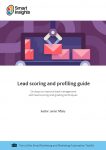Do your lead scoring right and it will drive sales through the roof
Lead scoring – it’s one of those terms which raises eyebrows outside the world of marketing, and rolls eyes within. Do it right and it will drive sales through the roof – but it’s so easy to get it wrong. And, when you get it wrong, you go haring off down dead ends while hot prospects cool off unnoticed.
That’s why I’ve teamed up with Smart Insights to create a comprehensive Lead Scoring Guide that will help you land quick wins through great lead scoring.
Our guide includes:
- What lead scoring is (and why your business needs it!
- An introduction to the different types of leads
- How to define lead qualification stages in B2B marketing
- Steps towards implementing lead scoring
- A guide to progressive profiling
- How to avoid common lead-scoring pitfalls
What is Lead Scoring?
Put very simply, ‘lead scoring’ means rating prospects based on their potential value to your organisation. Lead scores can (among other things!) help a business to prioritise their marketing activities. There are many ways to arrive at a lead score, but the most common involves ranking behaviour in relation to interaction with your brand. So, for example, if someone opens one of your marketing emails, their lead score would go up. It would rise even higher if they then clicked through to your website. Leads with a high score are more likely to convert, so it makes sense to focus more energy upon them. But that’s not the whole story…
How is it done?
Most marketing automation software will do the lead scoring donkey work for you. Which is brilliant. But don’t make the mistake of leaving it all up to the computers. For a start, you have to make sure that your software is ranking leads correctly. That means identifying which behaviours are most likely to lead to sales in your case. Which means that you need to go right back and consult your overall marketing strategy. Or read our strategic guide. Preferably both!
Then you need to manage your leads. Your sales team need to be able to see at a glance both which leads are hot, and the kind of specific information which will help them to convert those leads. Again, you can automate some of this with good marketing software, but strategic human input is vital!
Then there’s the whole process of working out what kind of lead you’re dealing with, the best way to nurture them, and how to keep them coming back. This lead scoring business is a lot more involved than you might think!
What can go wrong?
If you read our guide, nothing 😉
But seriously, there are a lot of issues you can run into. Some companies struggle to gain the accurate data you need to score leads properly. Many lead scoring software systems are a bit ‘classist’ and chase certain job titles or companies at the expense of hot leads elsewhere. To avoid these issues and more, we recommend that you read our comprehensive guide to getting quick wins through lead scoring.
